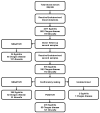Prevalence of Non-Viral Bloodborne Pathogens Among Healthy Blood Donors in Western Mexico: Problems and Failures of Public Health Policy
- PMID: 39770287
- PMCID: PMC11678354
- DOI: 10.3390/pathogens13121027
Prevalence of Non-Viral Bloodborne Pathogens Among Healthy Blood Donors in Western Mexico: Problems and Failures of Public Health Policy
Abstract
Background and objectives: Non-viral bloodborne diseases are a group of infections that are a public health problem worldwide. The incidence of diseases such as brucellosis and syphilis is increasing in the Americas and Europe. Chagas disease is an endemic problem in Latin America, the United States and Europe. This study aims to determine the prevalence of non-viral bloodborne diseases in blood donors and to discuss some issues related to federal regulations for the control and prevention of these infectious diseases in Mexico.
Material and methods: A cross-sectional study was conducted in the Western National Medical Center Blood Bank, including 228,328 blood donors (2018-2023). Frequencies, percentages, means, standard deviation and confidence intervals (CI) were calculated for demographic data. Prevalences were expressed as rates per 100,000 with 95% CI.
Results: Of 3949 seroreactive or undetermined blood donors at the first screening, a total of 682 (0.299%) completed their follow-up test and were positive for Treponema pallidum (478), Trypanosoma cruzi (83), or Brucella spp. (121). The overall prevalence for non-viral bloodborne diseases was 299 per 100,000 blood donors. The prevalence for syphilis, Chagas disease, and Brucella was 209, 36, and 53 per 100,000 respectively.
Conclusion: Federal regulations should be reviewed to formulate specific public health policies focused on controlling and preventing nonviral bloodborne diseases.
Keywords: Chagas disease; Mexico; blood donors; bloodborne pathogens; brucellosis; syphilis.
Conflict of interest statement
The authors declare that the research was conducted in the absence of any commercial or financial relationships that could be construed as potential conflicts of interest.
Figures
Similar articles
-
Seroprevalence and geographical distribution of sero-positive blood donors to Trypanosoma cruzi at the central blood bank of the National Medical Center "La Raza".Transfusion. 2019 Feb;59(2):639-647. doi: 10.1111/trf.15074. Epub 2018 Dec 5. Transfusion. 2019. PMID: 30520031
-
Sero-epidemiology of transfusion-transmissible infectious diseases among blood donors in Osogbo, south-west Nigeria.Blood Transfus. 2009 Oct;7(4):293-9. doi: 10.2450/2009.0071-08. Blood Transfus. 2009. PMID: 20011640 Free PMC article.
-
Prevalence of Trypanosoma cruzi antibodies in blood donors from Veracruz State, Mexico.Transfusion. 2015 Mar;55(3):647-56. doi: 10.1111/trf.12860. Epub 2014 Sep 11. Transfusion. 2015. PMID: 25208459
-
Estimating the current burden of Chagas disease in Mexico: A systematic review and meta-analysis of epidemiological surveys from 2006 to 2017.PLoS Negl Trop Dis. 2019 Apr 9;13(4):e0006859. doi: 10.1371/journal.pntd.0006859. eCollection 2019 Apr. PLoS Negl Trop Dis. 2019. PMID: 30964871 Free PMC article.
-
Chagas disease and transfusion medicine: a perspective from non-endemic countries.Blood Transfus. 2015 Oct;13(4):540-50. doi: 10.2450/2015.0040-15. Blood Transfus. 2015. PMID: 26513769 Free PMC article. Review.
References
-
- WHO . WHO Guidelines Approved by the Guidelines Review Committee. World Health Organization; Geneva, Switzerland: 2009. Screening Donated Blood for Transfusion-Transmissible Infections: Recommendations. - PubMed
MeSH terms
LinkOut - more resources
Full Text Sources
Medical
Miscellaneous



